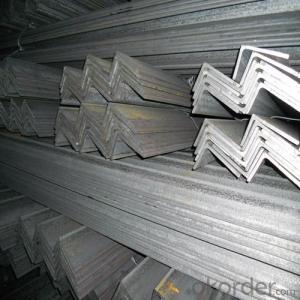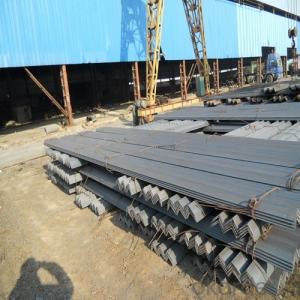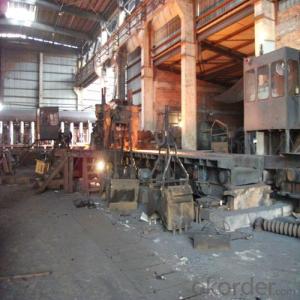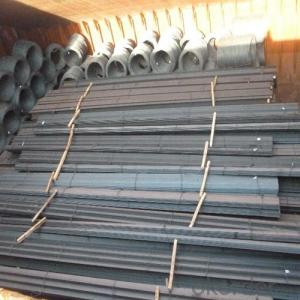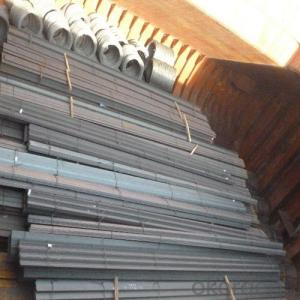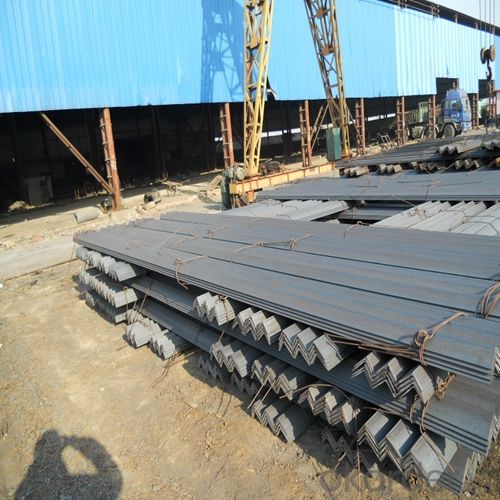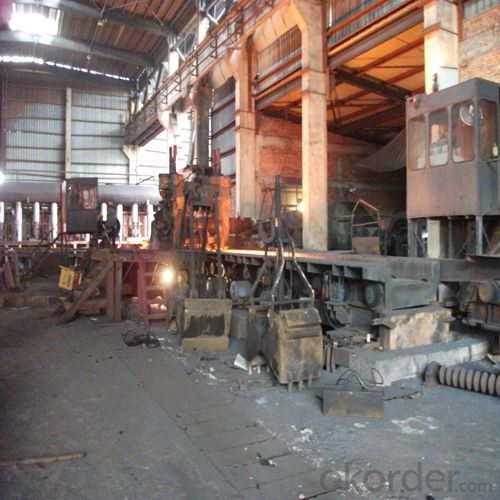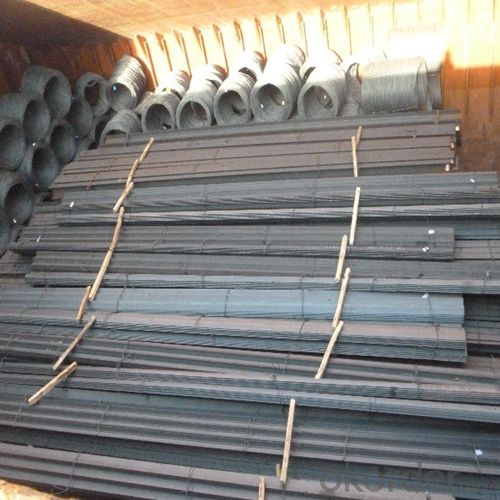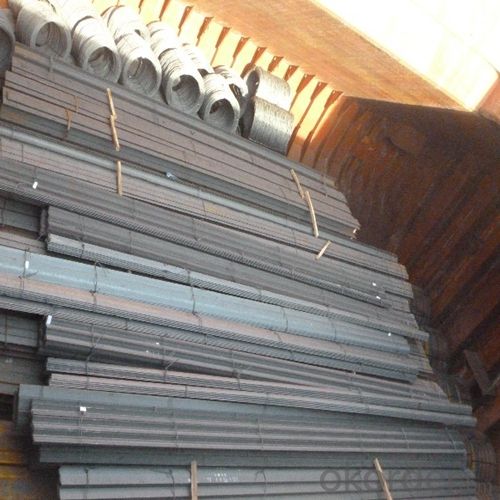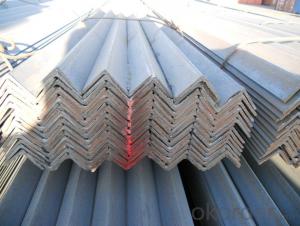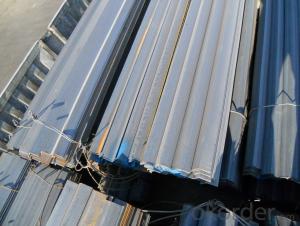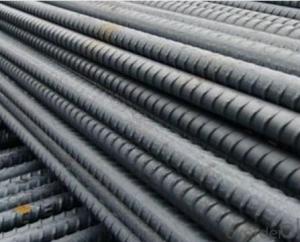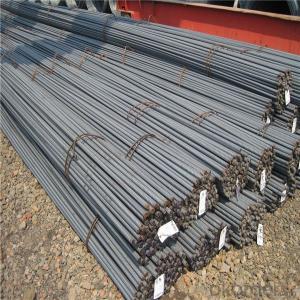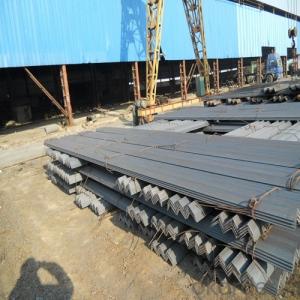Hot Rolled Angle Bar Steel 6M or 12M EN10025,JIS G3192,DIN 1026,GB 707-88
- Loading Port:
- Tianjin
- Payment Terms:
- TT or LC
- Min Order Qty:
- 100 m.t.
- Supply Capability:
- 20000 m.t./month
OKorder Service Pledge
OKorder Financial Service
You Might Also Like
Product Description:
Specifications of Angle Steel
1. Invoicing on theoretical weight or actual weight as customer request
2. Length: 6m, 9m, 12m as following table
3. Sizes

Sizes: 25mm-250mm | ||
a*t | ||
25*2.5-4.0 | 70*6.0-9.0 | 130*9.0-15 |
30*2.5-6.6 | 75*6.0-9.0 | 140*10-14 |
36*3.0-5.0 | 80*5.0-10 | 150*10-20 |
38*2.3-6.0 | 90*7.0-10 | 160*10-16 |
40*3.0-5.0 | 100*6.0-12 | 175*12-15 |
45*4.0-6.0 | 110*8.0-10 | 180*12-18 |
50*4.0-6.0 | 120*6.0-15 | 200*14-25 |
60*4.0-8.0 | 125*8.0-14 | 250*25 |
5. Payment terms:
1).100% irrevocable L/C at sight.
2).30% T/T prepaid and the balance against the copy of B/L.
3).30% T/T prepaid and the balance against L/C
6.Material details:
Alloy No | Grade | Element (%) | |||||
C | Mn | S | P | Si | |||
Q235 | B | 0.12—0.20 | 0.3—0.7 | ≤0.045 | ≤0.045 | ≤0.3 | |
Alloy No | Grade | Yielding strength point( Mpa) | |||||
Thickness (mm) | |||||||
≤16 | >16--40 | >40--60 | >60--100 | ||||
≥ | |||||||
Q235 | B | 235 | 225 | 215 | 205 | ||
Alloy No | Grade | Tensile strength (Mpa) | Elongation after fracture (%) | ||||
Thickness (mm) | |||||||
≤16 | >16--40 | >40--60 | >60--100 | ||||
≥ | |||||||
Q235 | B | 375--500 | 26 | 25 | 24 | 23 | |
Usage & Applications of Angle Steel
According to the needs of different structures, Angle can compose to different force support component, and also can be the connections between components. It is widely used in various building structures and engineering structures such as roof beams, bridges, transmission towers, hoisting machinery and transport machinery, ships, industrial furnaces, reaction tower, container frame and warehouse etc.
Packaging & Delivery of Structure Steel Angle Bar
1. Transportation: the goods are delivered by truck from mill to loading port, the maximum quantity can be loaded is around 40MTs by each truck. If the order quantity cannot reach the full truck loaded, the transportation cost per ton will be little higher than full load.
2. With bundles and load in 20 feet/40 feet container, or by bulk cargo, also we could do as customer's request.
3. Marks:
Color mark: There will be color marking on both end of the bundle for the cargo delivered by bulk vessel. That makes it easily to distinguish at the destination port.
Tag mark: There will be tag mark tied up on the bundles. The information usually including supplier logo and name, product name, made in China, shipping marks and other information request by the customer.
If loading by container the marking is not needed, but we will prepare it as customer request.
The angle is perpendicular to each other on both sides of the steel strip into the corner. There are equilateral angle steel and unequal angle points. An equal angle two edge width equal.
The angle is built with carbon steel, is a simple section steel steel, mainly used for metal components and the frame of the plant. In the use of the requirements are good, plastic deformation properties and a certain mechanical strength. The production of raw materials for low carbon steel billet steel billets, finished angle for the hot rolling, normalizing or hot-rolled state of delivery.
The specifications are expressed by the MM number of edges and sides and the thickness of the thick. Such as "/ 30 x 30 x 3", that is 30 mm equilateral angle edge width edge thickness was 3 mm. Also available models that model is the number of centimeters wide, such as angle 3#. Model doesn't mean thickness angle of different size in the same model, thus in the edge of the contracts and other documents will be angle width, edge thick size fill in complete, avoid separate model, said. The specifications for 2#-20# hot rolled equilateral angle steel.
The surface quality of the equilateral angle steel are specified in the standard and may not generally require the use of harmful defects, such as delamination, scarring, and cracks. Equilateral angle geometry error allowed range in the standard also provides, in general, including bending, edge width, edge thickness, dip angle and theoretical weight, and provides significant torsional angle not.
Angle according to the different needs of structure composed of a variety of stress components, can also be used as a component of the connections between the. Angle steel is mainly used for manufacturing the frame structure, such as high voltage transmission tower, steel structure bridge girder on both sides of the framework, tower crane of the column and arm lever on the construction site, workshop of column and beam, small place such as festivals roadside put pot in the shape of a shelf, in window hanging solar air conditioning such as shelves.
- Q: What are the different types of connections used for steel angles in industrial settings?
- Depending on the specific application and structural requirements, steel angles in industrial settings can be connected using various types of connections. Some commonly used connection types include: 1. Welded Connections: When high strength and rigidity are needed, welding is a popular method for connecting steel angles. This involves joining the angles using heat and pressure, resulting in a strong and durable connection. 2. Bolting Connections: Bolts and nuts are used to connect steel angles in this type of connection. It allows for easy assembly and disassembly, making it suitable for applications that require flexibility and adjustability. Bolting connections can be tightened or loosened as needed. 3. Riveted Connections: Metal rivets are used to connect steel angles in this type of connection. It offers good strength and stability and is commonly used in heavy-duty applications. Riveted connections require specialized equipment and skilled labor for installation and removal. 4. Adhesive Connections: Adhesives can be used to bond steel angles together. This type of connection provides good load distribution and is suitable for applications where welding or bolting is not feasible. Adequate surface preparation and adhesive selection are important for ensuring a strong bond. 5. Mechanical Connections: Cleats, brackets, plates, or clips can be used as mechanical connections to connect steel angles. These connections provide flexibility and ease of installation, allowing for adjustments and modifications in the future if necessary. It is important to consider factors such as load-bearing capacity, structural design, safety considerations, and environmental conditions when selecting the appropriate connection type for steel angles in industrial applications. Consulting with structural engineers and following industry standards and codes is crucial to ensure the correct connection type is used.
- Q: How do you connect two steel angles together?
- Welding is a commonly used technique for connecting two steel angles. It involves melting the angles' edges and joining them using an electric arc or flame, resulting in a durable and permanent connection. Before welding, it is vital to clean the surfaces to remove any impurities or rust. Furthermore, accurately aligning the angles and securing them with clamps or tack welds is essential to guarantee a precise connection. Another alternative for joining steel angles is using bolts or screws. This approach entails drilling holes through the angles and then fastening them together with nuts and bolts or screws. To achieve a strong connection, it is crucial to choose appropriate fasteners and ensure they are tightly secured.
- Q: What are the different types of steel angles available?
- There exists a variety of steel angles available, each specifically designed for particular applications and purposes. Examples of these include: 1. Equal Angle: These steel angles, also referred to as L-shaped angles, possess equal side lengths and are commonly utilized for general structural and construction purposes. They offer exceptional support and stability when interconnected with other structural components. 2. Unequal Angle: As the name implies, unequal angles feature different side lengths. These angles are frequently employed in applications where one side needs to be longer or shorter than the other, such as supporting uneven loads or creating specific shapes. 3. Stainless Steel Angle: Constructed from stainless steel, these angles exhibit high resistance to corrosion, making them suitable for applications where exposure to moisture or chemicals is a concern. They find common usage in food processing plants, chemical industries, and marine environments. 4. Galvanized Angle: Galvanized steel angles are coated with a layer of zinc, thereby providing excellent corrosion resistance. This makes them ideal for outdoor applications or areas exposed to high humidity or saltwater. 5. Rolled Steel Angle: Rolled steel angles are produced by rolling hot-rolled steel into the desired shape. This process enhances the angle's strength and durability, rendering it suitable for heavy-duty applications. 6. Slotted Angle: Slotted angles feature holes or slots along their length, facilitating easy attachment and adjustment. They are commonly utilized in shelving systems, workbenches, and storage racks, as they offer a versatile and customizable solution. 7. Structural Steel Angle: These angles are mainly deployed in construction projects requiring load-bearing support. They are designed to withstand heavy loads and provide structural stability in buildings, bridges, and other infrastructure projects. It is crucial to assess the specific requirements of your project before selecting the appropriate type of steel angle. Seeking guidance from a structural engineer or steel supplier can ensure that you choose the correct angle for your application.
- Q: Can steel angles be used for overhead support in industrial settings?
- Yes, steel angles can be used for overhead support in industrial settings. They are commonly used due to their strength, durability, and ability to bear heavy loads. Steel angles provide structural stability and are often utilized in the construction of overhead racks, platforms, and support systems in industrial facilities.
- Q: What are the different types of steel angle connections?
- There are several different types of steel angle connections commonly used in construction and engineering projects. Some of the main types include: 1. Welded connections: This is one of the most common and traditional methods of connecting steel angles. In this type of connection, the two angles are joined together by welding them at the point of contact. Welded connections provide excellent strength and rigidity, making them suitable for heavy-duty applications. 2. Bolted connections: Bolted connections involve using bolts and nuts to fasten the steel angles together. This method allows for easy disassembly and reassembly of the structure if needed. Bolted connections are often used in situations where frequent adjustments or modifications are required. 3. Riveted connections: Riveted connections involve using rivets to join the steel angles together. Rivets are metal fasteners that are inserted through pre-drilled holes in the angles and then hammered or pressed to secure them. Riveted connections were widely used in older structures and are still occasionally used in certain applications today. 4. Clipped connections: Clipped connections are a type of bolted connection where the angles are connected using special clip angles. These clip angles are bolted to the main angles, providing a secure and rigid connection. Clipped connections are commonly used in steel trusses and frameworks. 5. Gusset plate connections: Gusset plate connections involve using a steel plate, known as a gusset plate, to connect two or more steel angles. The gusset plate is usually bolted or welded to the angles, providing additional strength and stability. This type of connection is often used in structures subjected to heavy loads or dynamic forces. Each type of steel angle connection has its own advantages and disadvantages, and the choice of connection method depends on various factors such as the load requirements, structural design, and project specifications.
- Q: Are steel angles available in different finishes?
- Indeed, there are a variety of finishes available for steel angles. To enhance their appearance or provide extra protection against corrosion, steel angles can undergo different coatings or treatments. Some popular finishes for steel angles include galvanized, painted, or powder-coated options. Galvanized steel angles are coated with a layer of zinc to prevent rusting, while painted or powder-coated finishes offer a wide range of color choices for aesthetic purposes. Moreover, steel angles can also be left unfinished, creating a raw and industrial look. The diverse range of finishes for steel angles provides greater flexibility in their applications, allowing them to be customized to meet specific functional and aesthetic requirements.
- Q: Are there any environmental benefits of using steel angles?
- Using steel angles has numerous environmental advantages. To begin with, steel is one of the most recycled materials globally. When steel angles are no longer needed, they can be easily recycled into new steel products, thereby decreasing the demand for new steel production. This recycling process consumes less energy and resources compared to manufacturing steel from raw materials, resulting in significant energy savings and reduced carbon emissions. Furthermore, steel is a durable material with a long lifespan. This means that steel angles require less frequent replacement than other materials, leading to a reduction in waste generation. Steel's durability also means that it requires less maintenance and repairs over time, further minimizing its environmental impact. Moreover, steel is resistant to fire, pests, and rot, which reduces the necessity for chemical treatments and preservatives that can harm the environment. Additionally, steel angles have a high strength-to-weight ratio, meaning that less material is needed to achieve the same structural integrity compared to other materials. This not only reduces the amount of raw materials needed but also decreases transportation costs and fuel consumption during construction. Lastly, steel is highly versatile and can be used in various applications, such as construction and manufacturing. This versatility enables the creation of innovative and sustainable designs that optimize energy efficiency and decrease environmental impact. For instance, steel angles can be utilized in the construction of energy-efficient buildings that incorporate renewable energy systems, ultimately reducing overall energy consumption and greenhouse gas emissions. In conclusion, utilizing steel angles provides numerous environmental benefits, including decreased energy consumption, lower carbon emissions, reduced waste generation, and increased durability. These factors make steel angles a sustainable and environmentally-friendly choice for a range of applications.
- Q: How do you prevent steel angles from rusting in high humidity environments?
- To prevent steel angles from rusting in high humidity environments, several measures can be taken: 1. Protective Coatings: Apply a protective coating on the steel angles, such as paint, epoxy, or galvanization. These coatings act as a barrier between the steel surface and the surrounding moisture, preventing direct contact and oxidation. 2. Regular Maintenance: Conduct regular inspections to identify any signs of rust or damage. Promptly address any chips or scratches on the protective coating, as they can expose the steel to moisture and accelerate rusting. Touch up the coating as necessary. 3. Proper Ventilation: Ensure adequate ventilation in the area where the steel angles are located. Good airflow helps to reduce humidity levels, preventing excess moisture from settling on the metal surface. 4. Dehumidification: Install dehumidifiers or moisture-absorbing products, such as silica gel packets, to control the humidity levels in the environment. These devices help to remove excess moisture from the air, reducing the likelihood of rust formation. 5. Proper Storage: Store the steel angles in a dry and well-ventilated area. Avoid placing them directly on the ground or in contact with other metals that could cause galvanic corrosion. Elevating the steel angles on pallets or racks can help to prevent moisture accumulation. 6. Regular Cleaning: Regularly clean the steel angles to remove any dirt, dust, or salt deposits that could contribute to corrosion. Use a mild soap or detergent and a soft cloth or sponge to gently scrub the surface. Rinse thoroughly and dry completely. By implementing these preventive measures, the steel angles can be safeguarded against rusting in high humidity environments, ensuring their longevity and structural integrity.
- Q: Can steel angles be used in railway infrastructure?
- Yes, steel angles can be used in railway infrastructure. They are commonly used in the construction of railway tracks, bridges, and other structures due to their high strength, durability, and ability to withstand heavy loads. Steel angles provide structural support and stability, making them an essential component in railway infrastructure projects.
- Q: How do you calculate the torsional capacity of a steel angle?
- In order to determine the torsional capacity of a steel angle, one must take into account both the material properties and dimensions of the angle. The torsional capacity refers to the maximum torque or twisting force that the angle can withstand without experiencing significant deformation or failure. To calculate the torsional capacity, the following steps can be followed: 1. Measure the dimensions of the steel angle, including thickness, width, and length, in order to determine the cross-sectional properties. These properties include the area moment of inertia (I) and the polar moment of inertia (J). These values provide information about the angle's resistance to torsional forces. 2. Obtain the material properties of the steel angle, such as the yield strength (σy) and the ultimate strength (σu). These values indicate the maximum stress that the material can withstand before permanent deformation or failure occurs. 3. Calculate the torsional stress on the angle by using the applied torque (T). The torsional stress (τ) is determined by dividing the torque by the polar moment of inertia (τ = T / J). This calculation reveals the amount of twisting force experienced by the angle. 4. Determine the safety factor by dividing the yield strength of the material by the calculated torsional stress (SF = σy / τ). The safety factor represents the ratio of the maximum stress that the angle can withstand (yield strength) to the actual stress it experiences. A higher safety factor indicates a greater margin of safety. 5. Compare the calculated safety factor to a desired value. Depending on the specific application and design requirements, a minimum safety factor may be specified. If the calculated safety factor is below the desired value, it suggests that the angle is not suitable for the intended torsional load, and alternative angles or design modifications may be necessary. It should be noted that these calculations offer an estimate of the torsional capacity, and other factors such as the presence of holes, welds, or other geometric irregularities can impact the actual torsional behavior of the angle. Therefore, it is advisable to consult relevant design codes or professional engineering resources for detailed calculations and recommendations specific to the intended application.
Send your message to us
Hot Rolled Angle Bar Steel 6M or 12M EN10025,JIS G3192,DIN 1026,GB 707-88
- Loading Port:
- Tianjin
- Payment Terms:
- TT or LC
- Min Order Qty:
- 100 m.t.
- Supply Capability:
- 20000 m.t./month
OKorder Service Pledge
OKorder Financial Service
Similar products
Hot products
Hot Searches
Related keywords
